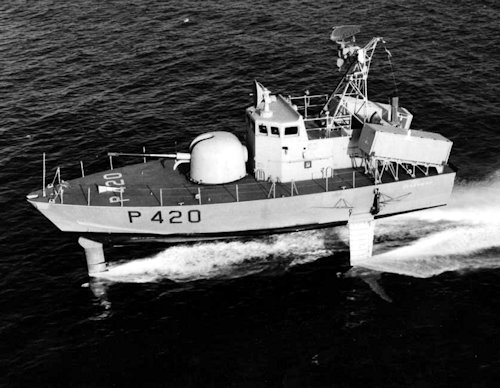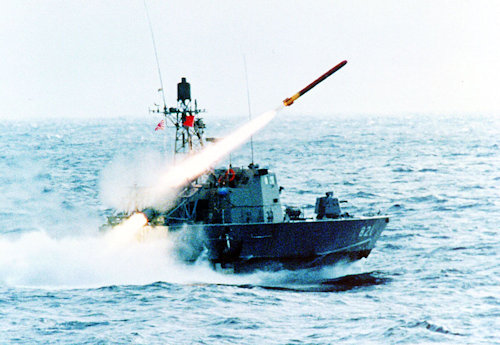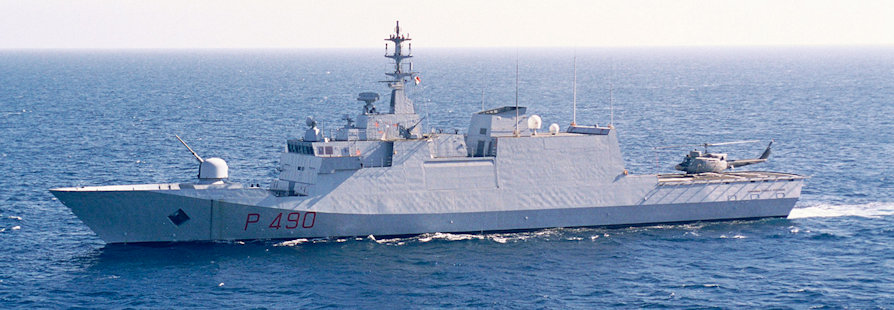In the last part of the Cold War the Italian Navy developed a series of small anti-ship units equipped with great firepower. They were the hydrofoils of the class Sparviero P-420, six fast ships as their names indicated: P-421 Kite, P-422 Falcon, P-423 Guru, P-424 Griffin, Kestrel P-425, Condor P-426. Units destined for anti-war warfare with a significant firepower over their modest tonnage. Built in the 80 years by the Italian Navy, they represented a technical-military innovation of war on the sea. Leaping all the concepts of traditional inspiration, the Navy chose a truly innovative solution for hull and engine gear, adopting the combat hydrofoil. The prototype was the one Sparrowhawk.
In 1964, a company was built in Italy called "Advanced Marine Systems-Hydrofoils"In which capital of Finmeccanica dei Cantieri Rodiguez of Messina and of the American Boeing Arcraft Co, which possessed the 60% of the shares, participated. The program of this new company was to design and build a combat hydrofoil derived from the "Tucumcari PGH-2 ", built by Boeing for the American Navy. A unit from 58 t, essentially conceived as an experimental prototype. After a few years, while the project called "Swordifsh"Assumed definite lines, the company was absorbed by the United Shipyard.
The fundamental operating concept of these new units was mainly a strong anti-missile capability, with alarm intervention regardless of the availability of equipped bases. In order to realize the use of hydrofoils, special mobile logistics support units were set up, which would have accompanied the hydrofoils along the national coasts. Made up of two trucks on which standardized containers were installed, including maintenance and repair shops, warehouses, offices, housing; each unit had 5 technicians specializing in the industries involved in the activity of hydrofoils.
The Group had services Operations, Weapons, Technical and Logistic, with official 15, of which 4 official superiors, with offices, canteens, housing, workshops and specialty school in the headquarters. The Group also had four mobile technical-logistic support columns, three of which sheltered, each with a Naval Genie TV, 6 non-commissioned officers and 6 men, able to support 2-3 units off-site even for significant periods. Various other types of vehicles for off-base support were also available.
 The speed of preparation was such that, in the event of an alarm, a firm, off and moored hydrofoil could be in dynamic accommodation in the open sea in about 15 minutes. The use in coastal operations was also foreseen in the project, with the additional installation of two light machine guns. The sparrowhawk intended for anti-missile interlocking tasks, with the possibility of patrol cruising, possessed an armament designed to focus a very high firepower despite the small size of the ship. His 2 missiles Otamat and the 76 / 62 cannon gave it great firepower even in clashes with higher naval formations. The high speed, 45 nodes, allowed him the tactics of the hit and run. The missile, which entered service in the 1974-75 after a long period of testing and evaluation, was preferred to Sea Killer Mk2 improved, which initially should have constituted the missile component of the sparrowhawk.
The speed of preparation was such that, in the event of an alarm, a firm, off and moored hydrofoil could be in dynamic accommodation in the open sea in about 15 minutes. The use in coastal operations was also foreseen in the project, with the additional installation of two light machine guns. The sparrowhawk intended for anti-missile interlocking tasks, with the possibility of patrol cruising, possessed an armament designed to focus a very high firepower despite the small size of the ship. His 2 missiles Otamat and the 76 / 62 cannon gave it great firepower even in clashes with higher naval formations. The high speed, 45 nodes, allowed him the tactics of the hit and run. The missile, which entered service in the 1974-75 after a long period of testing and evaluation, was preferred to Sea Killer Mk2 improved, which initially should have constituted the missile component of the sparrowhawk.
The trajectory profile was carefully studied for the safety of the launching ship and for the need to conceal the missile for as long as possible. The launch could also take place with sea force seven. Immediately after the launch, the missile quickly climbed up to 80 meters on the sea, then descended on a steep plane while maintaining an average 15 meters across the trajectory, dropping to two meters in the final stage.
Set in the 1971 lo sparrowhawk entered into service in the 1974, long tested these positive results in many stages of its use. Its hull was a special aluminum alloy and was subdivided into 5 watertight compartments: crew accommodation, logistics services and part turntable from 76 / 62, electronic equipment, central power plant and official accommodation, propulsion system. The superstructure was also made of aluminum alloy and contained the dashboard, the combat operations center and the air intakes for gas turbines. Stability is achieved with a system of gyroscopic and accelerometric sensors, controlled by a computer and implemented through control surfaces on the wing system, also used to maneuver the units in support. Water jet propulsion by means of a pump keyed on a Rolls-Royce gas turbine by 5000hp, with suction through the wing system and pushed through 2 nozzles placed at 2 / 3 of the hull (continuous speed over 45kts), the hydrofoils were also equipped with a diesel engine with aft foot for floating propulsion (v max 6kts) and 2 APU of aeronautical type for hydraulic and electrical generation (440 V 400 Hz.). The experimentation of the sparrowhawk convinced the Navy that the missile and missile combat hydrofoil could represent a dreadful weapon system to ban enemy naval movements in narrow seas and forced passages. Operational thinking immediately turned to the Adriatic and the Otranto Channel, to those of the Sicilian Channel, and to the insular systems of Italian waters.
 Allo sparrowhawk followed by other 6 units, built at the CNR-Alinavi of La Spezia, all improved and perfected. The original program included the construction of 8 hydrofoils of the class Kite and as such was included in the 1974-1984 Decade Naval Law; but the continued rise in costs led to the suspension of the construction of the last two units. The units were grouped into a Squadron, named COMSQUALI o Command Squadron Hydrofoils to the Command of a captain of frigate, which in turn depended on the Hydrofoil Group Headquarters based in Brindisi.
Allo sparrowhawk followed by other 6 units, built at the CNR-Alinavi of La Spezia, all improved and perfected. The original program included the construction of 8 hydrofoils of the class Kite and as such was included in the 1974-1984 Decade Naval Law; but the continued rise in costs led to the suspension of the construction of the last two units. The units were grouped into a Squadron, named COMSQUALI o Command Squadron Hydrofoils to the Command of a captain of frigate, which in turn depended on the Hydrofoil Group Headquarters based in Brindisi.
Il Hydrofoil Group he inherited the multi-purpose Warrior's Banner which was a god MAS before and after COMOS then, which today is preserved at the Vittoriano, awarded with Gold Medal for the action of Luigi Rizzo in Premuda of the 10 June 1918, and among other things, the only silver medal assigned to a Flag of the Royal Navy during the Russian campaign in World War II.
The hydrofoils were radiated between the 1997 and the 1999. The last disused examples, between the 2008 and the 2010, were those of the Japanese Navy that used three class units sparrowhawk built under license in Japan (photo).
In the Navy the role of hydrofoils is today covered by the New Fighting Minor Units, of the class Commanders (photo below), to which the names of destroyer commanders were assigned (cc Giuseppe Cigala Fulgosi, cc Costantino Borsini, cc Ener Bettica, cf Adriano Foscari) decorated with a Gold Medal for Military Valor for companies accomplished in the Second World War , whose operational capabilities are expanded by the availability of a helicopter on board.
 (photo: web / Global Security / Navy)
(photo: web / Global Security / Navy)












